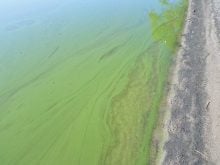The cereal leaf beetle is a relatively new insect pest to the Prairies, but farmers are going to start hearing a lot more about it. Although common in Eastern Canada, it was only first discovered near Lethbridge, Alta., in 2005. “Gradually, its abundance has increased until, in 2008, it was discovered in the eastern corner of Saskatchewan,” says Lloyd Dosdall, associate professor of entomology at the University of Alberta. “In 2010, the first reported spraying for cereal leaf beetle occurred in Alberta.” And according to John Gavloski, extension entomologist with Manitoba Agriculture, Food and Rural Initiatives, cereal leaf beetle was first discovered in that province in the Swan River Valley in 2009.
Read Also

Cancer agency reclassifies another herbicide ‘probably carcinogenic’
The WHO’s cancer research agency has now put atrazine, a herbicide well known to corn growers, in the same potential-hazard category where the agency put glyphosate.
BEETLE LIFE CYCLE
In spring, cereal leaf beetles emerge from winter cover in treed or bushy areas and start looking for host plants to feed upon and lay their eggs. Typically, the infestation is seen in winter wheat fields as they are the first green vegetation up in the spring. The larvae will then feed on the penultimate and flag leaf of the cereal, and pupate in late July or early August.
The beetle is quite distinctive, if very small, but because of its size can be confused with some other insects that look similar. It has an orange thorax, or middle section, and orange legs. It’s only about five to six millimetres long, and if you don’t know what you are looking for, it’s hard to find. On the other hand, the larvae are easy to find on the flag leaves and have a distinctive slug-like appearance. “If you didn’t know any different, you’d think you had a slug infestation on your cereal,” says Gavloski. The larvae feed on the leaf surface and the damage appears similar to that of a disease.
“This insect pest is what we call a grass specialist,” says Gavloski. “It doesn’t attack canola or flax, just cereals. And within that it prefers the small grains like wheat, oats, barley and rye. It will eat corn but it doesn’t do as much damage.”
PARASITIC CONTROL
“Although this insect is spreading steadily,” says Dosdall, “there is good news. An important parasite is known to follow and attack cereal leaf beetle in the larval stage.” Dosdall says thatTetrastichus julis,a tiny wasp, was initially imported from Europe and introduced into the U. S in the early 1970s. “It has since followed the beetles,” he says, “and there have
been releases conducted to ensure the wasp keeps up with the beetles’ progression.”
Gavloski agrees, saying “the parasite is really good at suppression. The wasp lays its eggs right on the larva, which are the main problem. Once infected, the larvae don’t feed as much — they become sick, essentially.” The beetle population can drop dramatically upon the release of the parasite. “The parasite is a very good control,” Gavloski says. “Spraying can do more harm than good by eliminating the parasite as well as the beetle. There are other natural controls like ladybird beetles (ladybugs) that like to eat the eggs and young larvae. They can go some way to keeping the beetle population in check as well. The best way to prevent cereal leaf beetle establishing itself as a pest with economic significance is to get the parasite well established.
The cereal leaf beetle larvae feed on the flag and penultimate leaves of cereal crops. The slug-like larvae will pupate by end of July or early August.
Adult beetles emerge in the spring to lay their eggs. Winter wheat fields are often the first infested because of the availability of green leaves early in the season.
Dosdall says, “My gut feeling is we are in the middle of a population expansion. Despite the wet summer in 2010 presenting a challenge to the beetle, it seemed to do fine. I have a suspicion it will keep increasing and spreading. “
Both entomologists advised farmers, agronomists and crop advisers to be on the look-out for this insect pest as they conduct field scouting this season. If there are any sightings or questions, either expert is more than happy to be of assistance.
AndreaHildermanhashermaster’sdegree inweedscienceandisamemberofthe ManitobaInstituteofAgrologists.Shewrites fromWinnipeg,Man.
———
A tiny wasp provides decent control by parasitizing the larvae














